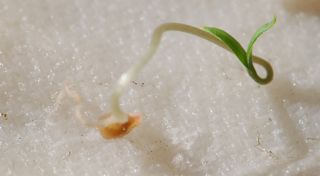Did you try the germination tests from last week? Did you get anything that looks like this?

If you enjoyed sprouting seeds, then here are a few more ideas for seed germination science experiments.
Before starting, however, let’s take a minute and think about how information from experiments on seeds and germination might be important. Last week we discussed how you could use a germination test to see if old seed you have lying around is still viable (able to make new plants). Plant scientists interested in maintaining rare plants, entrusted with ensuring maximum yields from crop plants and/or concerned with storing seeds in seed banks for the future study the changes in seeds over time and how to slow or prevent loss of viability. These scientists subject seeds to different conditions and examine the physical and chemical changes that occur as time passes. Their findings indicate that factors such as temperature, moisture, diseases, and chemical pollutants can all change seed viability.
Experiment 1. Effect of temperature on seeds and seed germination
Think of ways to test whether temperature effects seed sprouting or percent germination.
Example A:
Choose seeds of one kind of plant to test. (Note: Be sure to check the seed package carefully. Some seeds are treated with pesticides). Randomly assign the seeds to three categories. With the help of an adult, place 1/3 of the seeds on a paper towel or on a microwave safe plate and heat in a microwave on high for thirty seconds. Allow seeds, especially oily ones, to cool before touching them. Add 1/3 of the seeds in a freezer overnight in a freezer. Leave the remaining seeds at room temperature. Then perform a germination test as described last week. Count the number of seeds that germinated for each treatment and divide by the total of seeds (for that treatment) to obtain the percent germinated. If there are no differences, how can you modify this test?
Example B:
Choose seeds of one kind of plant and divide into three groups. Prepare each group for germination as discussed last week. Place one group in the fridge, one at room temperature and one in a sunny window or other place warmer than room temperature. Make sure they all stay moist but not too wet. Record the number of days until germination and also the percent germination (see Example B.)
Experiment 2. Rate of germination of seeds from different plants
Collect seeds from different plants (two examples of plants with vastly different germination times are radishes and carrots.) Perform the germination test as described last week.
Note: because radishes and carrots have different germination times, it is possible to plant them together in a garden. The radishes will come up and mature first. The slower carrots will benefit from the extra room left behind as the radishes are pulled out and used.
Experiment 3. Effect of chemicals or pollutants on seed germination
Use your imagination to come up with treatments that may increase or decrease germination. Think about things like salts (may be present in the water or soil), nutrients, and/or antimicrobial treatments that might change how many seeds of a given batch germinate.
As always, we would love to hear your ideas and/or results.

For further study:
Seeds and Plants (Science Workbook) by Diane O’Hanesian, John Jones (Illustrator)
Grades 2-3
This book does a good job with terminology and also showing concrete, real world examples. Better done than many science books for the younger set.
The Magic School Bus Plants Seeds: A Book About How Living Things Grow by Joanna Cole (Author), John Speirs (Illustrator), Bruce Degan (Illustrator)
For many more suggestions, visit our list of children’s books about seeds at Science Books for Kids.
And a treat for adults interested in science and plants:
Seed to Seed: The Secret Life of Plants by Nicholas Harberd
Disclosures: I am an affiliate for Amazon. If you click through the linked titles or ads and make a purchase, I will receive a small commission at no extra charge to you. Proceeds will be used to maintain this self-hosted blog.




